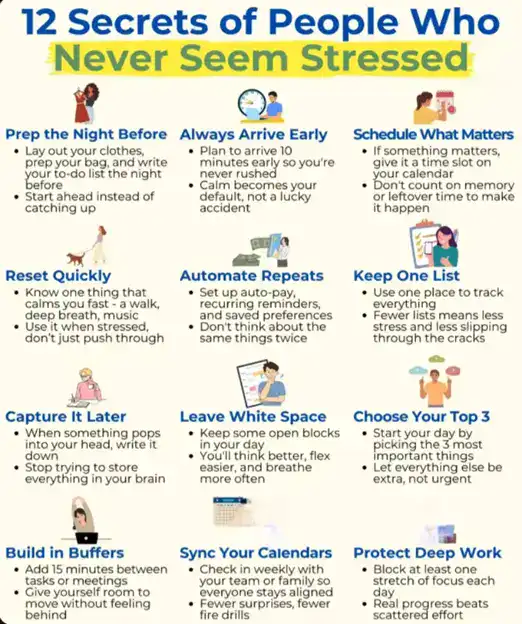Walk into any boardroom or leadership offsite. You can quickly identify the most effective person in the room. It’s not necessarily the smartest or the loudest. It’s the one who is composed.

In a storm of market volatility, investor pressure, and internal crises, the leader who remains calm doesn’t just feel better—they perform better. They make clearer decisions, inspire greater confidence, and navigate complexity without burning out.
This isn’t a personality trait; it’s a strategic discipline. The people who “never seem stressed” have simply built systems that make composure their default state. Let’s analyze these twelve “secrets” not as life hacks, but as the operating principles of a high-functioning executive.
The Foundation: Operational Rigor (Eliminating Friction)
The first layer of stress management is about removing the thousand small cuts that drain your cognitive energy.
- “Prep the Night Before” & “Automate Repeats”: This is systematizing the trivial. Your mental bandwidth is your most precious resource. Deciding what to wear or remembering to pay a bill depletes it. By creating routines and automations, you preserve your high order thinking for strategic decisions, not administrative trivia.
- “Keep One List” & “Capture It Later”: This is creating an external brain. A leader’s mind is a whirlwind of ideas, concerns, and obligations. Trying to keep it all in your head creates immense background anxiety. Trusting a single, reliable system (whether a notebook or a digital tool) frees you to be present and focused.
- “Sync Your Calendars”: This is proactive alignment. Most organizational stress comes from surprises. A weekly sync with your executive team to align priorities eliminates fire drills and ensures everyone is rowing in the same direction, dramatically reducing reactive chaos.
The Architecture: Strategic Time Management (Designing Your Day)
The second layer is about intentionally designing your time to support focus, not just reactivity.
- “Build in Buffers” & “Always Arrive Early”: This is the practice of margin. Back-to-back meetings with no transition time guarantee you will be perpetually behind and mentally fragmented. Buffers create space for synthesis, reflection, and simply moving from one task to the next with intention. Arriving early to appointments sets a tone of control.
- “Leave White Space” & “Protect Deep Work”: This is scheduling your strategic value. If your calendar is packed with meetings, you are operating as a coordinator, not a strategist. Defending blocks of “white space” and “deep work” is non-negotiable. This is where you do the thinking that actually moves the company forward.
- “Schedule What Matters”: This is a commitment device. You would never skip a board meeting or a key client call. Treat your health, strategic thinking, and learning with the same level of commitment. If it’s not on the calendar, it’s not a priority.
The Mindset: Tactical Composure (Managing the Moment)
The final layer is about having tools for the inevitable moments when pressure mounts.
- “Reset Quickly”: This is your emergency protocol. Every pilot has a checklist for emergencies. What’s yours? A 60-second breathing exercise? A walk around the floor? A specific piece of music? Identify and practice a quick reset ritual so you can deploy it under fire instead of being controlled by stress.
- “Choose Your Top 3”: This is ruthless prioritization. Feeling overwhelmed is often a symptom of unclear priorities. By defining your “Top 3” for the day, you create a lens through which to filter distractions. It empowers you to deprioritize the “urgent but unimportant” tasks that scream for attention.
The Bottom Line: Composure as a Competitive Moat
In the end, this isn’t about achieving a state of Zen. It’s about performance.
A stressed leader makes reactive decisions, stifles dissent by creating an environment of anxiety and ultimately becomes the bottleneck for their organization’s growth. A composed leader creates a ripple effect of calm focus, enabling the entire organization to execute with precision and resilience.
Your ability to manage stress is not a personal matter—it is a core component of your strategic leadership. It is the foundation upon which sound judgment is built.
The question is not whether you can handle the stress. The question is whether you have built a system that allows your best thinking to emerge because of it, not in spite of it.

